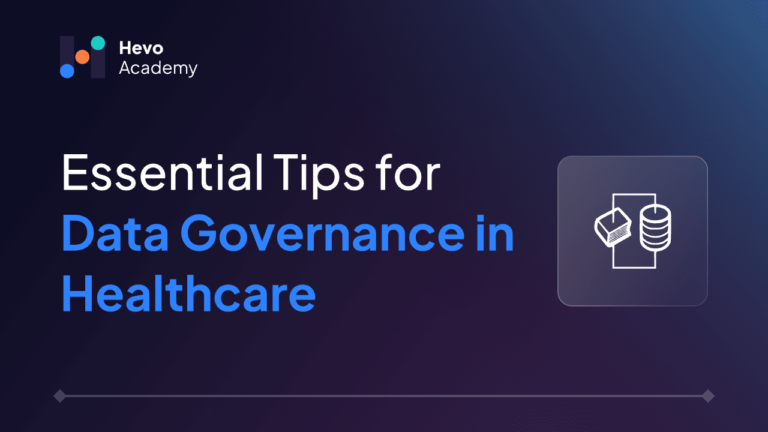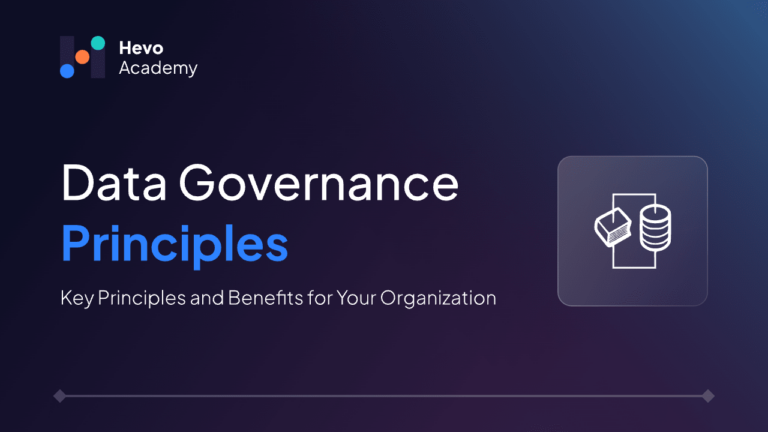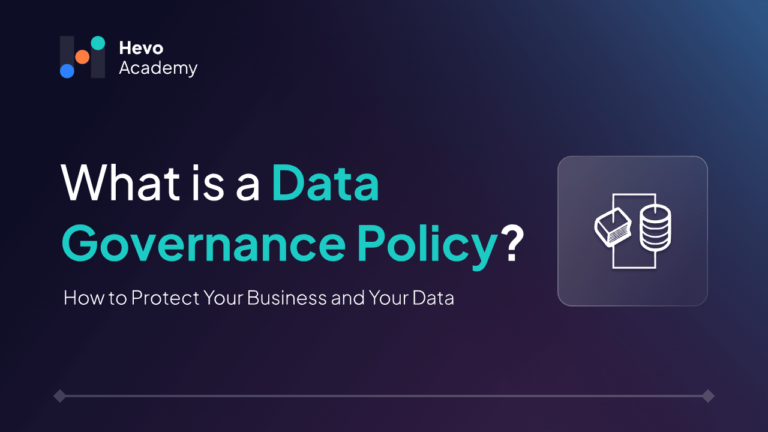Data is an essential component of organizations, but without proper governance, it can quickly shift from being an asset to a liability. With businesses handling growing amounts of data, the real challenge is creating systems that prioritize security, compliance, and the effective use of this critical resource. According to a Gartner report, fines related to inadequate data mismanagement, which include poor handling of the rights of data subjects, are expected to top beyond $1 billion by 2026 due to increased regulatory pressure.
Table of Contents
The blog discusses the changing dynamics of data governance, its importance to the data governance trends emerging in 2025, and best practices that will keep one ahead. Master these trends, from AI-powered governance to the integration of decentralized data models, and unlock your ability to enforce compliance, assure better data quality, and promote better decision-making.
What Is Data Governance?
Data governance is a systematic approach to policies, processes, and standards that ensures that an organization’s data assets are managed in an ethical, secure, and effective manner. Through clear roles and responsibilities and data standardization, governance transforms data into a strategic asset throughout its life cycle. It focuses on data quality, consistency, security, and compliance so that businesses can maximize their data by driving actionable insights while reducing risks.
Increased regulatory demands and competitive pressure are leading organizations to embrace data governance to achieve operational compliance, gain a competitive advantage, and enhance the utilization potential of their assets.
Why You Should Stay Updated With Data Governance Trends?
1. Navigating New Regulation
With new data privacy laws, such as GDPR and CCPA, and other rules and regulations worldwide, compliance is becoming increasingly important. Staying updated will help an organization avoid legal repercussions and maintain customers’ trust.
2. Leveraging Technological Advancements
Machine learning, AI, and automation, among others, are the technologies revising data governance plans. You must keep abreast of these developments to see how your organization may harness them for more efficiency and decision-making.
3. Mitigating Emerging Risks
Whether it is the expansion of unstructured data or ethical issues, all these new developments present new problems that demand active governance. Being ahead is the key to preparing for future contingencies.
4. Building Future-Ready Frameworks
The technologies reshaping data governance strategies include AI, machine learning, and automation. Be proactive to ensure your organization capitalizes on these developments to make decisions efficiently and effectively.
Top Data Governance Trends for 2025
1. Automation in Data Governance
Automation reduces manual effort by managing and organizing all the processes of compliance checking, metadata management, and reporting. Policy enforcement can be automated with consistency and accuracy in governance practices through tools such as Apache Atlas and Informatica.
2. AI and Machine Learning in Governance
Predictions of data quality issues, automatic data classification, and anomaly detection are just a few examples of how AI and ML improve data governance. This makes it possible to implement dynamic policies that can change when their surrounding environment does.
3. Challenges of Unstructured Data
Today, 80% of the data that enterprises collect, store, and analyze is unstructured—emails, videos, social media feeds, etc. Governance of this data entails using tools like NLP and AI to classify and extract meaningful insights.
4. Data Democratization
Data democratization allows non-technical teams to utilize the data they want safely. Governance policies must be implemented to mitigate the risks of access compromising security or compliance, and a good tool like Tableau or Power BI must be considered.
5. Data Compliance and Privacy
With new laws such as India’s DPDP Act and the emerging GDPR, privacy by design must be a preference. Automating the adherence to these frameworks lowers the risks of regulatory noncompliance.
6. Real-Time Data Governance
Real-time analytics require governance solutions that operate in real-time, providing validity, lineage, and policy compliance in seconds. This is important in industries such as e-commerce and finance.
7. Data Lineage and Metadata Management
Tracking data origins and transformations is crucial for establishing clear accountability and trust. Metadata management tools like Collibra also improve understanding, strengthen data source credibility, and increase transparency.
8. Decentralized Governance Models
Federated governance structures of responsibilities decentralize authority across departments while maintaining a unified standard. This facilitates scalability, accountability, and ownership while keeping standards high.
9. Cloud-Based Governance Solutions
New technologies, such as Snowflake and AWS Lake Formation, allow the application of comprehensive compliance measures at scale while minimizing costs. These solutions support hybrid or multi-cloud strategies.
10. Data Ethics and ESG Alignment
Governance is currently expanded by ethical data usage and data sustainability. ESG (environmental, social, and governance) goals can be best achieved when data practices are implemented in compliance with the data while at the same time encouraging trust and responsibility.
Challenges in Adopting Data Governance Trends
1. Complexity of Emerging Technologies
AI and automation are effective work methods that demand considerable skill and investment. Many organizations also struggle with adopting and incorporating technology into organizational governance systems.
2. Managing Unstructured Data
Unstructured data accounts for 80% of enterprise data, challenging organizations to manage its identification, classification, and handling. The absence of tools and related expertise compounds this challenge.
3. Balancing Compliance and Accessibility
While data democratization makes data more readily available, it also raises issues about non-adherence to regulations such as GDPR or CCPA. Another primary concern is having extremely open access while maintaining tight security measures.
4. Resistance to Change
Since new governance techniques differ from old processes, employees will always resist them. This situation requires attention and effort to remedy and enact the proper management training and transition for effective integration.
Best Practices for Staying Ahead in Data Governance
1. Invest in Advanced Tools
Metadata management, compliance monitoring, and common anomaly detection must be performed with the help of AI-based tools and automation platforms. This has helped to reduce manual input and, at the same time, improve the governance of the processes.
2. Prioritize Data Quality
The other is to set up a system to maintain and evaluate the quality of the data collected within the organization. Develop tools to establish standards and credibility in the various current data sets, making them reputable and easy to use.
3. Foster Collaboration
To effectively manage data, various departments should be involved in governance activities, including data stewards, IT departments, and business managers. Coordination also enhances the relationship between organizational goals and the overall compliance level.
4. Adapt to Emerging Trends
Keep pace with the dynamic legislation and advancements. Continually assess the organization’s governance structures and dislodge innovations such as real-time data governance or decentralized models to keep a competitive advantage.
Conclusion
Trends of 2025, such as automation, artificial intelligence, real-time governance, and decentralized models, define the future of data governance. These innovations help organizations control data responsibly without compromising privacy, compliance, or ethics. However, issues such as the challenge with unstructured data and changing regulations are best handled proactively. Adopting effective modern practices and current trends will help organizations create effective and sustainable frameworks for the successful governance of data that is currently a vital and valuable resource. With a focus on innovation and compliance, businesses can confidently tackle the challenges of modern data governance.
Try a 14-day free trial and experience the feature-rich Hevo suite firsthand. Also, check out our unbeatable pricing to choose the best plan for your organization.
FAQs
1. What is the future of data governance?
Automation, artificial intelligence, real-time governance, and decentralization are expected to shape the future of data governance. Its primary concerns are managing datasets, complying with continuously evolving regulations, and managing data to mitigate risks to security and privacy.
2. What are the three pillars of data governance?
The three facets of data governance are the roles and responsibilities of people, policies and procedures for data handling, and the usage of tools and technologies for data management, quality, and compliance.
3. What are the three key elements of good data governance?
Data governance can be considered under three key pillars: data quality, data security, and data compliance.
4. What is modern data governance?
Recent data governance addresses automation, artificial intelligence, and real-time value in terms of privacy, regulatory requirements, and growth. It supports cooperation and decentralization, provides equal access to information, and upholds data ethics in complex settings.





